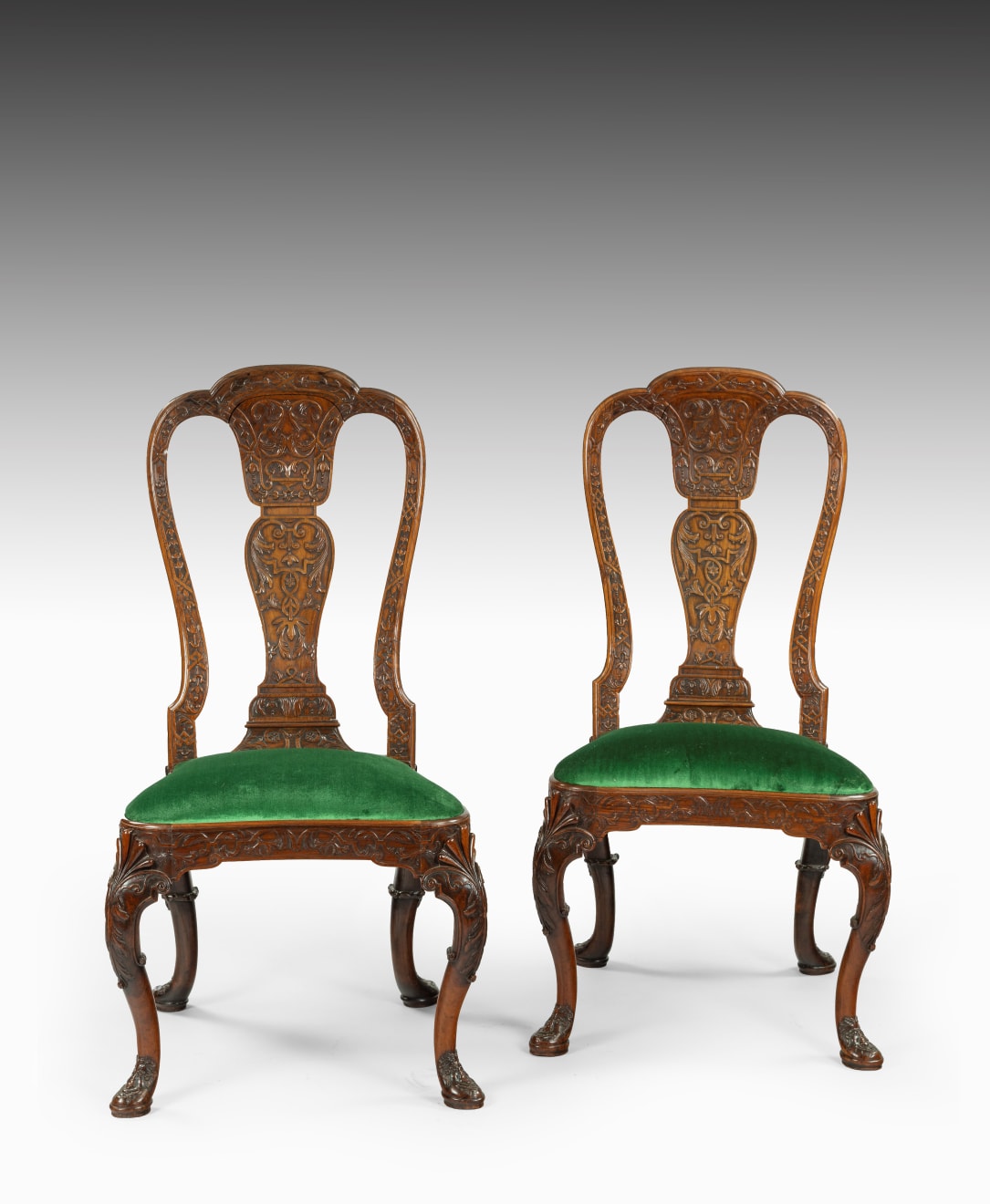SOLD TO THE ART INSTITUTE OF CHICAGO - Pair of Chinese Export Carved Padouk Side Chairs
CHINA, CIRCA 1730
107 x 54 x 59 cm
42 ¼ x 21 ¼ x 23 ¼ in
42 ¼ x 21 ¼ x 23 ¼ in
6862a
Further images
Made in padouk carved in low relief, the hooped back with an urn-shaped splat and curvilinear seat rails, decorated with stylized foliage, on hipped cabriole legs with carved shell and...
Made in padouk carved in low relief, the hooped back with an urn-shaped splat and curvilinear seat rails, decorated with stylized foliage, on hipped cabriole legs with carved shell and foliate decoration, terminating in carved pad feet decorated with grotesque masks. One of three pairs.
Chairs of this type were made in the East by Chinese craftsmen working under European supervision either on the mainland or at a trading centre such as Manila or Batavia. The richer and more abundant the decoration, as is the case for these chairs, the more expensive and luxurious the set. This remarkable work of sculpture tends to imitate the work of the English gesso, in relief and sculpted on gilded furniture. This pair of chairs is inspired by a George I design and is almost identical in shape and décor to another rosewood ensemble, exported by China and kept at Temple Newsam, Yorkshire (C. Gilbert, Furniture at Temple Newsam House and Lotherton Hall, Vol. II, Leeds, 1978, p. 492, No. 648). Our chairs are probably made by the same cabinet makers.
Two other sets of padouk chairs are closely related to this pair: one with sculptures on the seat belts and seating studs, the other with more sober decoration. These seats are located in Wilton House, Wiltshire (photographed in the dining room, J.M. Robinson, "Wilton House - Neo-Georgian delight," Country Life, January 20, 2010, pp. 52-53, fig. 2). A set of twelve chairs in walnut of the same form made in England was sold at Christie's, New York, on January 24 and 25, 2001, lot 90 ($182,000)
One of a pair of 18th Century Chinese rosewood dining chairs, dated circa 1740 – identical to the one discussed by Christopher Gilbert above – was owned by Jeremy Limited. Large sets of these chairs are at Hatfield and Wilton House.
One of a pair of Anglo-Chinese padouk side chairs, dated c.1720, was in the John Gerstenfeld collection and is listed in Masterpieces of English Furniture: The Gerstenfeld Collection (Edward Lennox-Boyd (ed.), (Christie’s, London, 1998), p.207, fig.31. Lennox-Boyd comments that: ‘A chair with this form of decoration from the Richard Milhender collection is illustrated in Crossman, The Decorative Arts of the China Trade, p.231, pl.83.'
Chairs of this type were made in the East by Chinese craftsmen working under European supervision either on the mainland or at a trading centre such as Manila or Batavia. The richer and more abundant the decoration, as is the case for these chairs, the more expensive and luxurious the set. This remarkable work of sculpture tends to imitate the work of the English gesso, in relief and sculpted on gilded furniture. This pair of chairs is inspired by a George I design and is almost identical in shape and décor to another rosewood ensemble, exported by China and kept at Temple Newsam, Yorkshire (C. Gilbert, Furniture at Temple Newsam House and Lotherton Hall, Vol. II, Leeds, 1978, p. 492, No. 648). Our chairs are probably made by the same cabinet makers.
Two other sets of padouk chairs are closely related to this pair: one with sculptures on the seat belts and seating studs, the other with more sober decoration. These seats are located in Wilton House, Wiltshire (photographed in the dining room, J.M. Robinson, "Wilton House - Neo-Georgian delight," Country Life, January 20, 2010, pp. 52-53, fig. 2). A set of twelve chairs in walnut of the same form made in England was sold at Christie's, New York, on January 24 and 25, 2001, lot 90 ($182,000)
One of a pair of 18th Century Chinese rosewood dining chairs, dated circa 1740 – identical to the one discussed by Christopher Gilbert above – was owned by Jeremy Limited. Large sets of these chairs are at Hatfield and Wilton House.
One of a pair of Anglo-Chinese padouk side chairs, dated c.1720, was in the John Gerstenfeld collection and is listed in Masterpieces of English Furniture: The Gerstenfeld Collection (Edward Lennox-Boyd (ed.), (Christie’s, London, 1998), p.207, fig.31. Lennox-Boyd comments that: ‘A chair with this form of decoration from the Richard Milhender collection is illustrated in Crossman, The Decorative Arts of the China Trade, p.231, pl.83.'










